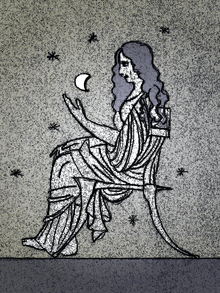Aglaonice
Aglaonice or Aganice of Thessaly (Ancient Greek: Ἀγλαονίκη, Aglaoníkē) was a Greek astronomer of the 2nd or 1st century BC.[1] She is mentioned in the writings of Plutarch[2] and in the scholia to Apollonius of Rhodes[3] as a female astronomer and as the daughter of Hegetor (or Hegemon) of Thessaly. She was regarded as a sorceress for her ability to make the moon disappear from the sky, which has been taken to mean she could predict the time and general area where a lunar eclipse would occur.[4][5]

A Greek proverb makes reference to Aglaonice's alleged boasting: "Yes, as the Moon obeys Aglaonice".[6] A number of female astrologers, apparently regarded as sorcerers, were associated with Aglaonice. They were known as the "witches of Thessaly" and were active from the 3rd to 1st centuries BC.[6]
In Plato's Gorgias, Socrates speaks of "the Thessalian enchantresses, who, as they say, bring down the moon from heaven at the risk of their own perdition."[7]
Plutarch wrote that she was "thoroughly acquainted with the periods of the full moon when it is subject to eclipse, and, knowing beforehand the time when the moon was due to be overtaken by the earth's shadow, imposed upon the women, and made them all believe that she was drawing down the moon."[8]
One of the craters on Venus is named after Aglaonice.[6] As "Aglaonice", she is a character in the Jean Cocteau film Orpheus, where she is a friend of Eurydice and leader of the League of Women. Aglaonice is a featured figure on Judy Chicago's installation piece The Dinner Party, being represented as one of the 999 names on the Heritage Floor.[9]
See also
References
- Peter Bicknell: "The witch Aglaonice and dark lunar eclipses in the second and first centuries BC." In: Journal of the British Astronomical Association, Bd. 93, Nr. 4, pp. 160–163, Bibcode: 1983JBAA...93..160B
- "Plutarch, De defectu oraculorum, section 13". www.perseus.tufts.edu.
- Scholion to Argonautica 4.59
- Ogilvie, Marilyn Bailey (1986). Women in Science. The MIT Press. ISBN 0-262-15031-X.
- Schmitz, Leonhard (1867), "Aganice", in Smith, William (ed.), Dictionary of Greek and Roman Biography and Mythology, 1, Boston, p. 59
- Howard, Sethanne (2008). Hidden Giants (2nd ed.). Lulu.com. p. 31. ISBN 9781435716520.
- "Gorgias". fordham.edu.
- Plutarch, Conjugalia Praecepta
- "Aglaonice". Elizabeth A. Sackler Center for Feminist Art: The Dinner Party: Heritage Floor: Aglaonice. Brooklyn Museum. 2007. Retrieved 17 December 2011.
